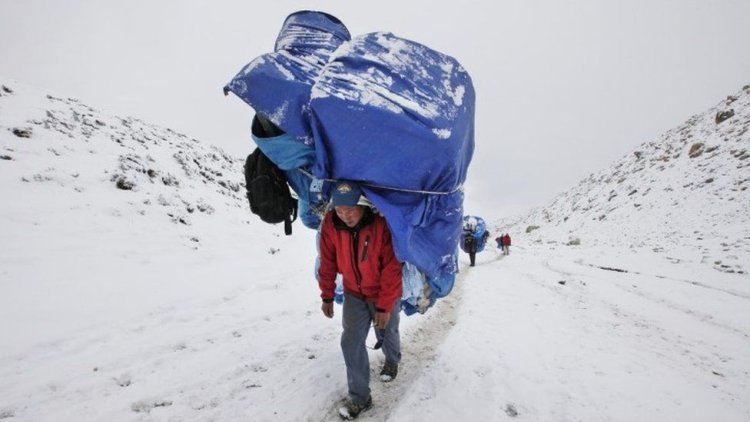Himalayan Sherpa: Guardians of the World's Highest Peaks
Unveiling the Himalayan Sherpas: Guardians of the World's Highest Peaks - Explore their culture, challenges, and vital role in mountaineering.

Tucked away amidst the majestic peaks of the Himalayas, the Himalayan Sherpa community has played a pivotal role in the world of mountaineering and trekking for decades. With their unparalleled knowledge of the mountains and unwavering determination, Sherpas have become the unsung heroes of numerous expeditions, supporting and guiding climbers in their quest to conquer the world's highest peaks. This article sheds light on the unique culture, history, and crucial role of the Himalayan Sherpa people in the context of mountaineering, exploring their deep-rooted traditions and their vital contributions to the global climbing community.
-
The Sherpa Heritage and Way of Life:
The Himalayan Sherpas, an indigenous ethnic group, have inhabited the challenging terrain of Nepal, Tibet, Bhutan, and the Indian Himalayas for generations. With a culture deeply intertwined with the mountains, Sherpas have developed a profound understanding of the local ecosystem and weather patterns. They follow a unique way of life, preserving their customs and religious practices despite the challenges posed by modernity. Sherpa communities foster strong bonds, relying on each other for support, which is crucial for their survival in the harsh mountain environment. -
Sherpas in Mountaineering History:
The Sherpa people's exceptional mountaineering skills first gained recognition during the early 20th century when British explorers began their quest to conquer the Himalayan peaks. Sherpas accompanied these early expeditions as guides and porters, showcasing their invaluable expertise and courage. The historic 1953 British Everest expedition, led by Sir Edmund Hillary and Tenzing Norgay, a Sherpa, marked a turning point in mountaineering history. Tenzing Norgay's summit of Everest alongside Hillary made him a legendary figure and inspired countless Sherpas to pursue a career in mountaineering. -
The Role of Sherpas in Modern Mountaineering:
In the present day, the popularity of mountaineering has soared, and the role of Sherpas has become even more crucial. As professional mountaineering guides, they lead and organize expeditions, ensuring the safety and success of international climbers. Sherpas carry heavy loads, set up camps at high altitudes, and navigate treacherous terrain, allowing climbers to focus on their ascent. Their physical and mental endurance, combined with their vast experience, make them indispensable members of any Himalayan expedition. -
Sherpas as Environmental Stewards:
Beyond their mountaineering expertise, the Sherpa community has become a vital force in advocating for environmental conservation in the Himalayas. With firsthand experience of the region's fragility, they understand the importance of preserving the delicate ecosystem. Sherpas actively participate in sustainable tourism initiatives, promoting responsible trekking practices, and engaging in local conservation efforts. Their commitment to protecting their homeland ensures that future generations can continue to enjoy the pristine beauty of the Himalayas. -
Empowering Sherpa Women in Mountaineering:
Traditionally, mountaineering was a male-dominated field among the Sherpa community. However, in recent years, Sherpa women have broken barriers and entered the world of mountaineering as climbers, guides, and expedition leaders. This shift represents a significant step towards gender equality within the community and serves as an inspiration for young Sherpa girls aspiring to follow their dreams. Empowering Sherpa women not only elevates their status but also brings diverse perspectives and strengths to the field of mountaineering. -
Challenges Faced by Sherpas:
While the Sherpa community is an integral part of the mountaineering world, they encounter several challenges that deserve attention and support. These challenges arise due to a combination of factors, including increased tourism, environmental concerns, and labor-related issues. Recognizing and addressing these challenges is crucial to ensure the well-being and sustainable development of the Sherpa people and their unique culture.
-
-
Environmental Degradation:
The surge in mountaineering and trekking activities in the Himalayas has led to environmental degradation. The increasing number of climbers and trekkers results in higher amounts of waste, including plastic bottles and food wrappers, which pose a significant threat to the delicate mountain ecosystem. Sherpas, who deeply understand the importance of preserving their natural surroundings, face the challenge of maintaining a balance between promoting tourism and protecting the environment. -
Overcrowding on Mountains:
Popular peaks like Mount Everest experience overcrowding during peak climbing seasons, leading to safety concerns and challenges in managing the flow of climbers. Sherpas often find themselves navigating congested routes, resulting in slower progress and higher risks of accidents. Managing these large-scale expeditions while maintaining safety standards is a major challenge faced by Sherpa guides. -
Safety Hazards and High-Risk Professions:
Sherpas take on high-risk professions as expedition leaders, guides, and porters. The dangerous and unpredictable mountain conditions, including avalanches and crevasses, put their lives at risk. Despite their expertise and experience, the inherent dangers of their work pose ongoing challenges to ensure their safety and well-being. -
Inadequate Compensation and Fair Treatment:
There have been instances where Sherpas have faced exploitative labor practices, receiving inadequate compensation for their strenuous work on climbing expeditions. This disparity in payment and treatment compared to international climbers raises concerns about fair treatment and equity in the mountaineering industry. -
Cultural Impact of Globalization:
As tourism and modernity seep into the Himalayan region, there is a concern about the impact on Sherpa culture and traditions. The younger generation faces the pull of globalization, which can sometimes lead to a loss of traditional values and practices. Preserving their cultural heritage in the face of rapid change is a challenge that the Sherpa community grapples with. -
Limited Economic Opportunities:
While mountaineering and tourism have provided economic opportunities for many Sherpas, the income generated from these activities might not be equally distributed within the community. Creating diverse economic opportunities beyond mountaineering, such as sustainable agriculture or cultural tourism, is a challenge that can help enhance the livelihoods of the entire Sherpa population. -
Lack of Representation:
Sherpas often face underrepresentation in decision-making processes within the mountaineering industry and local governance. Increasing their involvement in discussions and decision-making related to tourism and conservation can help address their concerns and ensure their perspectives are considered.
-
Addressing these issues is essential to ensure a sustainable and equitable future for the Sherpa people and the mountaineering industry.
In Conclusion, The Himalayan Sherpas are the guardians of the world's highest peaks, their knowledge, resilience, and culture deeply intertwined with the mountains they call home. From the early days of mountaineering to the present, Sherpas have played an indispensable role in shaping the world of climbing. Their contributions go beyond guiding and supporting expeditions; they are environmental stewards, cultural ambassadors, and trailblazers for gender equality. Recognizing and appreciating the Sherpa community's significance is not only a matter of respect but also vital for fostering sustainable and collaborative relationships between the global climbing community and the Sherpa people for generations to come. Together, they can continue to protect and preserve the Himalayas, ensuring that these magnificent peaks remain a source of wonder and inspiration for adventurers around the world.
What's Your Reaction?




































































































